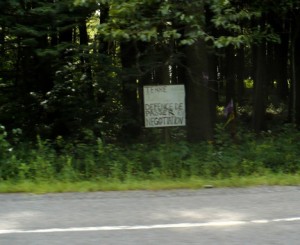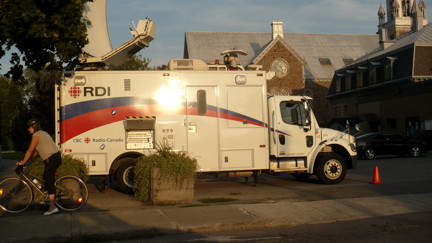Doin’ the Oka Shuffle
You’ve probably heard via the news media that “Oka is heating up again.” That there are “rising tensions with Mohawks on the 20th anniversary of the Oka Crisis.” Maybe you’ve heard that “Mohawks are angry with a developer” who wants to build on land he says he bought, fair and square, but that the Mohawks say is “part of their ancestral lands” or even “sacred lands.”

Newspeople put this plot “across the road from land the Mohawk claim is an ancient, sacred burial ground.” Reporters also describe it as the place where “the Mohawk barricades went up 20 years ago” and where the “armed standoff with Mohawks began,” etc., etc.
The language is interesting. The area that the Mohawk “claim” to be an “ancient, sacred burial ground” is a fenced-in cemetery, complete with great big signs saying it’s a cemetery, and lots of headstones. But the word “cemetery” is boring. So reporters or their producers and editors insert words and phrases that connote some mysterious tribal significance, an almost religious or spiritual import to the events unfolding at Kanehsatake. They use this type of language despite charges by the Mohawk that the story is much more mundane: that it’s about a carpetbagger from Montreal seeking to flip some land and make some money.
On the one hand, you might say that journalists in both print and broadcast media are simply adding contextual phrases, using creative language to convey cultural differences and meanings. You might even describe the language as selling the story by raising interest to bring legitimate concerns to audiences and readerships.

Media folks might appreciate those descriptions, but they’d bristle at the slightest suggestion of deliberate use of paternalistic phrases that belittle Mohawk positions, or imply a childlike inability by Mohawks to articulate complex political and financial arguments. They’d also deny like the dickins that overall coverage portrays the developer as an average Quebec landholder (“us”) versus the Mohawks (“the other”). Journos, of course, are notoriously thin-skinned.
What of this Mohawk complaint? Has any reporter bothered to go beyond merely repeating statements and accusations from one side or the other? According to one reported Mohawk theory, the developer has deliberately created a confrontation to pressure a government buyout so he and his partners can make a hefty profit. According to the developer, the Mohawks are threatening him with violence, preventing him from exercising his private property rights, while the provincial police turn a blind eye to these Mohawk criminals. Instead of checking out either story, the media seems content to be stenographer to both sides.
Of course, the Mohawk band council hasn’t been asked nor given the chance to answer some obvious questions: like, where’s the beef? Sure, there’s that difference between what the developer paid for the land (reportedly about $100,000) and the amount he wants before he’ll walk away from the deal (between $400,000 to $500,000). But the band council hasn’t looked at previous buyouts or attempted buyouts to see if there’s a pattern or trend by speculators hoping to exploit similar situations.
For its lack of due diligence, the band council should gets failing grades in Basic Research and PR. For example, the band council hasn’t produced promises about this land made 20 years ago by Quebec and Ottawa to the Mohawks. But the band council shouldn’t be the only group concerned with this bit of history. The media has a responsibility here too.
Twenty years ago, Canadian governments promised to secure land around Kanehsatake as it became available, transfer these parcels of land to the Mohawk so they could have one solid territory instead of a checkerboard. In exchange, Mohawks said they’d lay down arms and dismantle the barricades, satisfied with government guarantees that the theft of their lands would end.
You’d think it might be instructive if people knew how well governments have done to keep those promises since 1990. Y’know, like how much land has been transferred from the Federal government to the Mohawk Territory? How many properties have been bought and sold in the surrounding area in that same period of time? How much land has been lost to Kanehsatake as housing development continues to encroach and erode. Or how this key piece of property — right in the Pines — escaped the attention of these ever-vigilant governments, always anxious to keep their 20-year old promises and preserve the Honour of the Crown? (snark)
In short, the band council could be doing a much better job to remind people about their issues —and educating the news media (and Canadians) as well. But, without facts, the band council is just blowing a lot of hot air. Meanwhile, both the developer and governments emit blather and pious whoo-ha while reporters scurry about trying to look knowledgeable.
I tend to see things from the Mohawk point of view. So I understand how the band council might overlook such details, important as they are. What I cannot understand is why news organizations with a lot more people and resources haven’t bothered to dig deeper into an important story.
All the major networks have had news uplinks parked in the town of Oka ready to break into programming at any moment. At points, reporters outnumbered Mohawk protesters in the Pines. Reporters seem, however, less interested in researching the story than hoping for some bang-bang.
But, hey, this is the summer news doldrums! Where’s the fun in research?
Ah, what the hell: let’s do that Google thang for them. Here’s what I found in about a half an hour on the subject of Mohawk land, outstanding land claims, housing developers, and nearby Canadian villages. It wouldn’t take much to find similar stories in every province and just about every reserve. But let’s keep it to Mohawks.
Here’s one story that broke through the national yawn a few years back, with a tip of the hat to the Hamilton Spectator:
- “Developer doesn’t know where to turn: Hagersville landowner says he hasn’t heard from federal, provincial governments since natives occupied his land”
Here’s something more current on this same story, from Feb. 22 of this year:
Let’s head on over to Tyendinaga, near Belleville, ON, where similar tensions over similar issues (land and developers) echo those at Caledonia. First up, stories from the Kingston Whig Standard:
- “Mohawk roadblock ordered down; Premier Dalton McGuinty says blockades were a ‘real concern’ to police”
- “Developer confronted by native protesters; ‘We didn’t permit it to escalate,’ man says of tense encounter on disputed land in Deseronto”
- “Town haunted by history”
- “Mayor could have forestalled protest“
- “Crown should buy land and return it to Mohawks”
Now, a few stories from the Belleville Intelligencer:
For a slightly different take on the story at Tyendinaga Mohawk Territory, here are some j-students weighing in for the Online Pioneer at Loyalist College:
- “Mohawk land claim dispute unresolved”
- “Land owner considering settlement over Culbertson Tract dispute”
Yep, half an hour on Google. The Kanehsatake band council and reporters covering the story at Kanehsatake have absolutely no excuse. Both could have done much better in educating themselves — and the public — about these issues.
In the end, we were all cheated and short-changed.


2 thoughts on “Doin’ the Oka Shuffle”